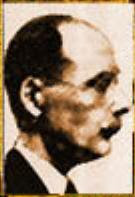In any field of human intellectual endeavor, the
'sine qua non' of
'eternal' excellence are
the three classical hallmarks known as erudition,
eloquence, and elegance. All these
three, in turn, entail various qualities, as it will be mentioned
below. They are the indispensable legs of the tripod on which
true quality of the timeless transcendental kind rests, which may
be best expressed by the single word:
excellence.
Mathematics is a rather unique intellectual endeavor.
Unquestionably one of the greatest triumphs of the human
intellect -- and by the same token, a truly great tribute to it
-- mathematics enables one to go 'where no one
has gone before' or to borrow a literary
phrase, 'where even angels fear to
tread'. Now, in this essay, I
don't wish to get drawn into such disputes as
Platonic vs. Aristotelian mathematics, or whether mathematics is
discovered or created or both; and I have no intention either to
discourse on merits and shortcomings, or to engage in any kind of
sermon for or against mathematics. Quite simply, the purpose of
this paper is to draw attention to just what
constitutes excellence in mathematics,
regardless of the idiosyncrasies of any particular mathematician,
whether still living or already standing in the Pantheon, frozen
in lofty marble among eternal geniuses. In other words,
don't expect here a cookbook recipe for
winning the Fields Medal, quite regardless
of how smart and (mathematically) knowledgeable you might be. You
need much originality in this field, despite a huge amount of
indispensable basic knowledge and rapid developments in every
branch; and it is fair to say that no matter how impersonal
mathematics appears, your own cognitive style and
pattern-recognition gifts leave plenty of room for individuality
in this special, infinite playground of the intellect.
However, none of the above justify the first sentence of the
previous paragraph. Mathematics is unique because the
man-made and the nature-made
get intimately intertwined in it; and both components are
present in every branch of mathematics, no matter where you look.
But the proportions may be very different. In probability and
statistics, number theory, and the like, the man-made aspect
predominates so much that the nature made component can only be
discerned with specific effort; whereas in most areas of
mathematical physics, the nature-made aspect is not only
conspicuous, but must even be given priority, at least
according to the vast majority of (theoretical) physicists.
Also, there have been shifting emphases on these components
throughout history; but it is only in relatively recent times,
that mathematics has gradually become independent of natural
philosophy at first and from physical significance at last. This
emancipation has taken about a century, roughly between the
non-Euclidean geometries of Gauss, Bolyai, and Lobachevsky in the
early XIXth century until the Quantum Mechanics of Planck, Bohr,
Schrödinger, Heisenberg, Born, Dirac, et al. around the
1930s. Dirac, in particular, in a famous quote has gone as far as
asserting that if there is a discrepancy between experiment and
mathematics, one ought to jettison the experiment and retain the
mathematics. Today, maybe 10% or so of advanced mathematics has
physical meaningfulness; and mathematical research merrily
proliferates following its own recipes, in disdainful disregard
of physics or even philosophy except perhaps for the part of
philosophy which belongs to logic in general and mathematical
logic in particular. In other words, the man-made component has
become overwhelmingly, maybe to 90%, predominant over the
nature-made component; and this is precisely why mathematics is
so unique, considering that no matter where we look, it
works.
A word of qualification is in order. It works, and ubiquitously
at that; but this is still in our world of human
sense-perception. How it may or may not work independently of the
'bubble' of virtual reality
within which its human creators perforce live, remains an open
question. If there is such thing as ultimate reality, it may or
may not be adequately handled by our mathematical sophistication.
One might conjecture, that human limitations can but result in
projections of those limitations into other worlds, assuming that
such worlds exist, quite independently of us. Also, with regards
to extraterrestrial life, no matter how probable it is that such
life is intelligent, there's no reason
whatsoever, to suppose that those life-forms evolved intelligence
along human lines. To be sure, there are certain mathematical
things that we have reason to believe, are universal; for example
the prime numbers, as it was eloquently emphasized in the late
Cornell astrophysicist Carl Sagan's
masterpiece: "Contact". But unless
and until some way is found for interstellar communication and
travel, we have no means to confirm or disconfirm such
conjectures. Perhaps some future discovery will rob the
'Queen of Sciences' of her
crown, but until then, mathematics reigns supreme, and we ought
to bow to her.
Erudition is the first and perhaps most
obviously important requirement for mathematical excellence.
Little comment is needed. One must be intimately familiar with
advanced mathematics in order to attain mastery. In fact, no
attainment of mastery is possible before every detail has become
so intuitively evident, that one can run circles around it and
devise alternatives. It's just that the rapid
growth of every branch of mathematics makes it increasingly
difficult to master but ever narrower segments of specialities. A
curious situation arises whereby the more one knows about
specifics, the less one is able to keep sight of the whole, all
the way until the absurd predicament of knowing everything about
almost nothing. Already a hundred years ago this was well stated
in one of Poincaré's theorems,
according to which the more one approximates a mathematical
truth, the more elusive it becomes. This recent proliferative
trend has produced more and more 'specialist
barbarians', which, of course, is at the
expense of erudition, because erudition requires much general
knowledge in addition to specialized competence in whatever
narrow aspect of mathematics. This applies to both pure and
applied fields of mathematics, although perhaps attains greater
importance in the pure fields, because it is here that the
specialization tendencies are the most pronounced. It is fair to
say that today's mathematicians are less
erudite in a general sense than ever, no matter how competent
they may be in some highly specialized area. The only solution to
this predicament is synthesis, whereby many
seemingly disparate aspects are brought to common denominators;
and the resultant simplification gives rise to
generalization, which then makes room for new
growth cycles. Generalization is one of the most important
aspects of the growth of mathematics, being the key to
usefulness. Interestingly, the greater the generality, the
greater the simplicity. This is one of the main reasons why
advanced mathematics is easier than the less advanced parts.
Simplicity also greatly facilitates the other two requirements of
mathematical excellence: eloquence and elegance, by getting rid
of unwanted or unnecessary information and drawing attention to
the important facts. Simplification by generalization was most
eloquently illustrated by David Hilbert, the second
'Prince of Mathematicians'
(the first was Gauss) in 1890, when he proved
Gordan's 1868 theorem by throwing away 90% of
Gordan's premisses and putting the rest into
the form which is known as Hilbert's Finite
Basis Theorem. This far-reaching and profound theorem shows
eloquently and elegantly that greater generality and greater
simplicity are practically inseparable.
Eloquence, as the second requirement for
mathematical excellence, might strike a strange note.
That's because eloquence is traditionally
associated with rhetorics and the fluent, polished, and effective
use of language, especially in public speaking. Yet the same
argument or proof may be presented clumsily or eloquently. An
eloquent proof immediately appears as smooth, almost natural flow
of ideas, without even a trace of unnecessary or cluttering
information. Obviously, a prerequisite of eloquence is thorough
mastery of the field in general and the problem in question in
particular. Yet, technical mastery is not enough. One needs a
certain creativity and imaginative playfulness, as well as
originality and style. This brings us to the third leg of the
tripod: elegance.
Elegance, as the third requirement for
mathematical excellence, is the truly artistic aspect. Its
hallmarks are grace and refinement, ingenuity and simplicity,
extraordinary effectiveness and efficiency. To explore, to
discover patterns, to explain the significance of each pattern,
to invent new patterns similar to those already known, are among
the normal activities of what mathematicians do. How they do what
they do depends on the quality of the mathematician. An
excellent
mathematician has an almost inimitable style, but despite much
idiosyncrasy, the style will invariably be elegant.
The history of mathematics is marked by alternating
contractions and expansions, analyses and syntheses, unifications
and generalizations. If all of mathematical knowledge could be
expressed in two principles, the excellent mathematician would
not rest until s/he could demonstrate that the two are rooted in
a single one. But that would give rise to new problems, and new
cycles of expansions-contractions-expansions. Such pulsation has
been characteristic of the growth of mathematics throughout
history in erudite, eloquent, and elegant ways. As mathematics is
both science and art, it may perhaps be
fairly said, that erudition stands for science, elegance for art,
and eloquence bridges the two of them.




































